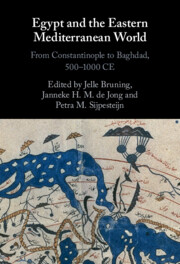Book contents
- Egypt and the Eastern Mediterranean World
- Egypt and the Eastern Mediterranean World
- Copyright page
- Contents
- Figures, Graphs, and Tables
- Notes on Contributors
- Notes on Transliteration, Names, and Dates
- Preface and Acknowledgments
- Additional material
- Introduction
- Part I Political and Administrative Connections
- Chapter 1 Egypt in the Age of Justinian: Connector or Disconnector?
- Chapter 2 At the Crossroads of Regional Settings: Egypt, 500–1000 CE
- Chapter 3 The Frontier Zone at the First Cataract before and at the Time of the Muslim Conquest (Fifth to Seventh Centuries)
- Chapter 4 Islamic Historiography on Early Muslim Relations with Nubia
- Chapter 5 Local Tradition and Imperial Legal Policy under the Umayyads: The Evolution of the Early Egyptian School of Law
- Chapter 6 Ibn Ṭūlūn’s Pacification Campaign: Sedition, Authority, and Empire in Abbasid Egypt
- Part II Economic Connections
- Part III Social and Cultural Connections
- Index
- References
Chapter 1 - Egypt in the Age of Justinian: Connector or Disconnector?
from Part I - Political and Administrative Connections
Published online by Cambridge University Press: 01 December 2022
- Egypt and the Eastern Mediterranean World
- Egypt and the Eastern Mediterranean World
- Copyright page
- Contents
- Figures, Graphs, and Tables
- Notes on Contributors
- Notes on Transliteration, Names, and Dates
- Preface and Acknowledgments
- Additional material
- Introduction
- Part I Political and Administrative Connections
- Chapter 1 Egypt in the Age of Justinian: Connector or Disconnector?
- Chapter 2 At the Crossroads of Regional Settings: Egypt, 500–1000 CE
- Chapter 3 The Frontier Zone at the First Cataract before and at the Time of the Muslim Conquest (Fifth to Seventh Centuries)
- Chapter 4 Islamic Historiography on Early Muslim Relations with Nubia
- Chapter 5 Local Tradition and Imperial Legal Policy under the Umayyads: The Evolution of the Early Egyptian School of Law
- Chapter 6 Ibn Ṭūlūn’s Pacification Campaign: Sedition, Authority, and Empire in Abbasid Egypt
- Part II Economic Connections
- Part III Social and Cultural Connections
- Index
- References
Summary
Until comparatively recently it was common for historians of the ancient and medieval periods to treat Egypt as a world unto itself which was only partially drawn into the broader political and cultural currents of the Mediterranean first by the “fiery genius of Alexander” (as Harold Idris Bell put it), and then by the imperial ambitions of Rome, which effectively treated it as a colony.1 Even for much of its Roman history, it was claimed, Egypt stood apart in terms of language, culture, religion, and social and economic institutions, inheriting a particularist legacy that placed it at some remove from the mainstream of Greco-Roman culture, and which would be bequeathed in the Islamic period to the haughty patriarchs of the Coptic Church.
- Type
- Chapter
- Information
- Egypt and the Eastern Mediterranean WorldFrom Constantinople to Baghdad, 500-1000 CE, pp. 19 - 45Publisher: Cambridge University PressPrint publication year: 2022

